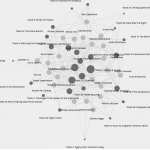Reading the opening paragraph from Richard Saul Wurman’s (1996) book The information architect describing the sheer amount of data as a tsunami of unorganized chaos has made me reflect on current influencer culture. In order to make it big on any of the social media apps, like tiktok or snapchat or instagram, you need to be updating your feed daily. Creating new content continuously lest you be forgotten. It is inarguable that creating new content daily is a huge task and that there will likely be a shift for quantity over quality. This makes sense when you watch the consumer habits of young people on these apps, they scroll through multiple peoples stories in a minute, pausing when something looks vaguely interesting and simply swiping by when they aren’t immediately hooked. You can find videos of people doing pretty much anything for a few more followers, including pranking their loved ones, licking toilet bowls and generally being overexposed on the internet. There is not end to the onslaught of new “information” that is being created. I have tried to embrace this culture in my reimagined “what’s in the bag” activity by mimicking a type of content known as unboxing. You can watch people take items out of a package and slowly move them in front of the camera. Something about the anticipation is part of the pull and if done well (which mine is not) the viewer will willingly spend several minutes of their lives watching someone take a new game out of an amazon box. Creating an unboxing video, loosely based on the genre is an aspect of design since, as the New London Group’s article states, “The notion of Design recognizes the iterative nature of meaning-making, drawing on Available Designs to create patterns of meaning that are more or less predictable in their contexts.” (1996, p.76).
Another interesting aspect of influencer culture is the complete mashup of audio, visual & written information all working together in different ways to make a successful post or story or stream. Most stories on instagram or tiktok will have subtitles strategically placed, that the user has gone to the trouble of adding in to their story because a large majority of people watch stories on mute. They will also have captions that pull you into the story, things like “watch until the end” or “you won’t believe what I saw” which cause the user to watch the whole video, cleverly giving them more of your screen time. Users of these medias contextualize the experiences based on their understanding of the purpose of the stories. In a sense it is evidence for the claim from the New London Group that “human knowledge is primarily situated in sociocultural settings and heavily contextualized in specific knowledge domains and practices.” (p.84) The other mishmash of semiotic forms is in the use of captions and emojis and tags that crop up in their own caption but also in all of the comments that viewers make on their stories. I am not a researcher in the realm of semiotics but it might be interesting to look at what users of these social media platforms are doing to these different modes of communication and how they are using them simultaneously and for cross purposes at times.
The information overload is not limited to social media and influence content creation but it is a telling trend and it isn’t a new idea. I wrote an essay for a contest in high school (it was indeed a long time ago) about this idea. The fact that, to be proficient in a certain industry or field you need to know so very much information and that once you are well versed in, for instance, particle physics, you will have spent almost no time studying geopolitics or law etc. and so there will be a divide between the information one field has that may benefit another and no bridge to join the two. I was in high school a long time ago and at the time I was not thinking about the internet as this vaste source of knowledge. The concept of overwhelming information is definitively not a new one and the organization of that information is a struggle.
In terms of modes of information transfer I think there will always be a place for the written word, be it on paper or through a screen. As I have grown older I have realized that everyone laments changes, especially those that seem to come from the younger generation that you are no longer a part of. However I hope that in the end we are all wrong in our lamentations and that people continue to find new means to continue to communicate with one another. Communication is after all what makes us humain.
References:
Richard Saul Wurman (1996). Information Architects.
The New London Group. (1996). A pedagogy of multiliteracies: Designing social futures. Harvard Educational Review 66(1), 60-92.
Dobson and Willinsky’s (2009). Digital Literacy Cambridge Handbook of Literacy.
Photo by David Švihovec on Unsplash







Ying Gu
March 1, 2021 — 21:55
Hi Olivia,
I love that you did an unboxing video! It is indeed so relevant at this time. Since a part of digital literacy is understanding how media is created, I believe that through your analysis, you have demonstrated this aspect perfectly. You outlined the layers of work behind one unboxing video: the text overlays, the audio overlays, etc. It is cool to think that this sort of analysis is automatically taking place at the back of our minds as we watch videos online. The same sort of thinking doesn’t occur when we read a book, or at least for me it doesn’t.